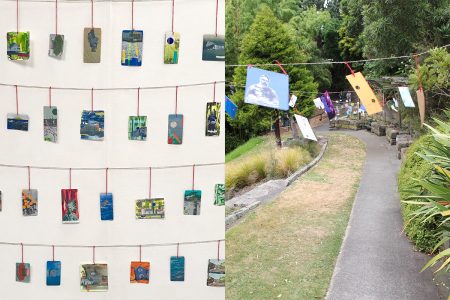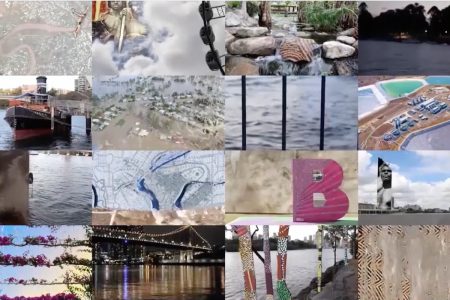Art & Design Faculty- Ava and James Werner featured in Cal Poly Magazine
Understanding Our Waterlinks
Original story by Robyn Kontra Tanner, Cal Poly Magazine
“What water do you come from?”
It’s a question the Māori people of New Zealand ask instead of “How are you?” or “Where are you from?” when meeting someone new. Unlike those questions, which focus on the individual, the inquiry immediately grounds the conversation in one’s connection to the natural environment.

Waterlinks postcards hang in Cal Poly’s art gallery (left) and in a park in New Plymouth, New Zealand (right). Images courtesy of Jim and Ava Werner.
Ava and Jim Werner, faculty in the Art and Design Department, learned about this custom when they stayed with the Māori as part of a creative residency program in 2015. It inspired the concept for an innovative, participatory art installation they called “Waterlinks.”
“We were looking to capture community perspectives on climate change,” Jim said. Creating art that encouraged participation and engaged communities made the daunting concept feel more personal and urgent, he added.
The installation was first shown in New Zealand before moving to the island of Chuuk in Micronesia; Brisbane, Australia; Cal Poly’s campus art gallery; Bangor, Maine; and a Columbia University gallery in New York City.
Each iteration of the project began in a similar way: the Werners researched and documented the natural and man-made water sources in the community, then developed an immersive installation.
Jim created interactive video compilations — moving collages of people and scenery — using touchscreens and projections. Ava developed handmade hanging artworks using local imagery and histories, including mixed media postcards for viewers to take home. Whenever possible, she centered visuals and historical context involving Indigenous communities and immigrant populations.
Each installation took a different shape, adapting to bustling markets, public parks and sleek art spaces. People shared wide-ranging perspectives and anecdotes that stitched together in an expanding tapestry represented on video screens added with each stop.

A video display representing different water sources and perspectives on water. Image courtesy of Jim and Ava Werner.
Participants explored how other communities responded to the question, “What water do you come from?” and then shared their own perspective in a written or video diary. Each new response would fold into the project and add to a living narrative as the installation traveled to new environments around the world. Collectively, the stories showed that climate change was truly a global issue, and no one was immune to its effects.
In Micronesia, community members talked about the cleansing power of weather despite having just survived devastating hurricanes. At Cal Poly, Mustangs told childhood stories set against a landscape parched by extreme drought. In Brisbane, which had recently seen catastrophic flooding, one participant talked about the network of rivers that connected disparate communities. One New Yorker recalled a time decades ago when he watched the river burn due to unchecked pollution in the water.
“What was amazing about this project is how much we discovered and learned from people and how generous people were telling their stories — some of them were just so beautiful and poetic,” said Ava. “[Water] is layered into every experience of our lives. There’s something really beautiful about that and also something that connects us all.”
One of the project’s first accounts from a Māori sailor painted a stunning picture.
“She was talking about how, when you’re out in the ocean at night and it’s calm, the stars reflect on the water so it looks like you’re floating in the universe,” said Ava.
The treasure trove of heartfelt and thoughtful engagement has sustained and motivated the pair, who hope to bring their art and the climate change conversation back to New York City this summer and potentially collect some of the project’s visuals and testimonials in a book.
“This piece is about you making a statement about how climate change has affected you — it really draws the question back into each individual,” said Jim. “[Viewers] are not there just to look at a piece of artwork and make a judgment of it. Instead, the artwork is looking back at them, saying, ‘How are things affecting you? Can you contribute to this?’
“You are now part of the piece.”
Read the the full feature in "Our Climate Future: Water" at Cal Poly Magazine